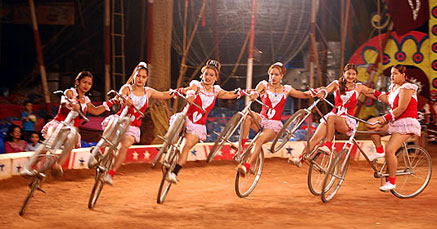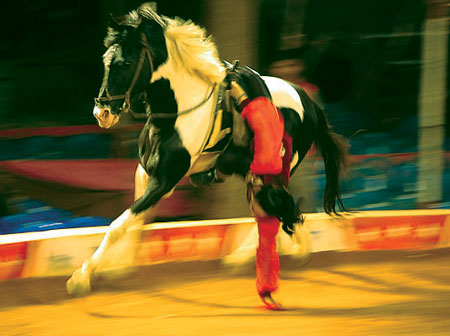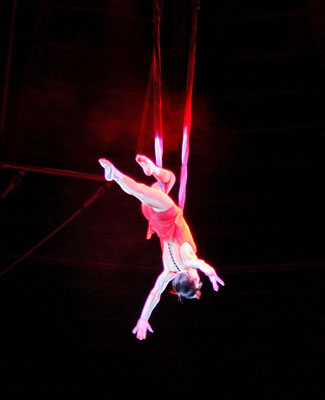The circus arena in India witnessed signs of changes in the initial decades of the 20th Century. This was with the entry of Keralites in the field of circus. Sri Keeleri kunchikannan Teacher was the frontrunner in this historic transformation in the Indian Circus.
The circus camp established by Sri. Keeleri Master attracted large number of adventurous youth. Keeleri was of the hope that the trained youth would get opportunities in circus units run by Maharashtrians. However his hopes were not fulfilled. His trainees joined other fields and the training camp became unsuccessful.
After a few years, one of his trainees by name Pariyali Kannan approached Keeleri Master with his intention to start his own circus company. He had some savings after working with an European Bioscope Company along with poovadan kunchambu and M.K. Raman which he wanted to invest for establishing a circus camp and for procuring the necessary equipments. He wanted Keeleri Master to train the artists and performers in the proposed circus camp. Thus Keeleri Master started his training camp again in Thalassery.

Performers from Thalassery including Pariyali, Poovadan Kunchambu, Poovadan Govindan, Irimban Kanari, Kunnathu Yasodha, Velandi Madhavi and M.K. Raman from Calicut joined the training camp. Keeleri trained them in different items according to their physical and mental make up.
Till that time even in European Circus, horizontal bar item was performed with one or two bars. Keeleri introduced several new items using three horizontal bars and trained M.K. Raman. As M.K. Raman had prior experience in ‘parichamuttukali’, and somersault, he had extraordinary body flexibility which helped him master the bar items quickly.
‘Kamba kali’ is another item contributed by Keeleri Master to the Indian circus. He designed this by combining the tight rope walk and other rope arts practiced by the nomads of southern India. The ‘kamabkali’ was first performed on stage by Keeleri’s brother in law, Sri. Chandu alias Charls. He provided training in items like Frog jumping, foot juggling, foot acrobat, pole on the wall, boneless, roman rings, Arian Trapeze, weight lifting, loo swear etc. After three years of continuous training, the highly proficient Keeleri Master prepared a team of performers required for a circus camp.
Thus the first circus camp from Kerala was erected in the fields at Chirakkara. The name of the circus was Pariyalees Malabar Grant Circus. The circus camp was inaugurated by Sri Keeleri Master himself. The first women performer of the Kerala,circus, Kunnath Yasoda, also staged her show on the inaugural day. The first Indian lady in circus was Avada bai who had performed for the Chatres Circus.
Several adventurous youth came forward to join the Circus Camp. Many of them were from poor families. During the training period, Keeleri Master did not seek any remuneration. He was interested only in the growth of the art of circus. Within 20 years, trainees of Keeleri Master conquered the Indian circus arena. Within this period apart from the maharashtrians, people from Karnataka, Andhra and Bengal had started their own circus companies. Majority of the performers in these companies were from Kerala.
In 1920s students of Sri Keeleri Master returned to the circus. They started Keeleri Kunhikannan Junior WhiteY Circus initially. Kallan Gopalan Great Raiman Circus was started thereafter. Both these ventures were growing from success to success day by day. This inspired several others to join the circus field. M.K. Raman started Star of India, Chirammal Karunthandi Ambu started Grand Fairy and Krishnan Master started South Indian Ladies Circus.

Keeleri’s students also did not do justice to him in a proper manner. He has only one memorial in Kerala-The tomb at CSI Church cemetery at Illikkunnu near Thalassery. Each Circus Camp in Kerala may be a monument for his dedicated service to the Circus Art. But Keeleri is unknown even to the inmates of these circus camps today. Thalassery Municipality also did not evince any interest till date to establish a suitable memorial for him- At least by naming a road after him.
The second, third and fourth decades of the last century was the golden era of the Indian circus art, the period when Keeleri and his students were prominent in the circus field. That was the period when the performers in the circus stages competed with different artistic items with passion and high spirits.
With the increase in number of the circus camps owned by Keralites, large number of girls from Thalassery and Kannur area was attracted towards the circus camps. The financial difficulties in the aftermath of the Second World War were the major driver in bringing these girls to the circus field in such a large numbers.
When girls came to the circus in large numbers, the dominance of men in the circus got reduced. Women entered into various adventurous items which was previously performed by only men. Women started performing even the difficult items such as ‘Kambakali’ in the early 1950’s Maithili from Thalassery of Grant Fairy Circus was the first women who performed ‘Kambakali’ Many bold women performed adventurous items like ‘Ladder Balance’, Stunt Cycle, Loose Wire, etc. in different circus camps.
Kamala Circus returned to India in the mid fifties of the 20th Century after 10 years of foreign camping. Its arrival pushed the Great Raiman Circus to second position. Professor K. Damodaran, owner of the Kamala Circus was a brave, talented professional and an excellent showman in the circus field.
Professor Damodaran also gave importance to women artists in the circus camps. He introduced several items in the Indian circus in line with the various foreign items. He brought prominent artists and rare animals from foreign countries to bring about charm in the Indian circus camps. This was how items like Table Scatting, Trumpolin, Springnight etc were introduced to the Indian Circus.
Kamala Circus was the most famous three ring circus born in Thalassery. Professor K. Damodaran was the owner of the Kamala Circus. He was son of Krishan Teacher who was colleague of Keeleri Master at BEMP School.
The South Indian Ladies Circus started by Krishnan Teacher became the Kamala Circus in 1944. K. Damodaran was a greatest showman in the Indian Circus. He was a proficient trainer and planned to start a circus training centre at his native place Kathiroor and constructed a building there for the purpose. Though the building was completed, he could not fulfill his wish.
He was recognized as a distinguished personality who took the circus art in India to its peak of glory. He also received praise from the then prime minister of India Sri. Jawaharlal Nehru. Kamala Three Ring Circus was the biggest circus Company on those days. Kamala Circus introduced three rings in October 1956 at Nagpur Circus Camp. It grew into Asia’s largest Circus Company and the second largest in the World. Professor Damodaran, who brought about significant changes in the Indian Circus, died in 1966. Soon in 1976, his circus company also came to an end.

In the 1970’s the young generation in Kerala lost interest in the circus field. The poor wage structure, the high risk factor and the lack of proper amenities in the circus camps had defaced the attractiveness of the circus art by that time. The respect, friendship, dedication and care shown by the early owners of the circus companies were not followed by the owners of the new companies. The commercial tendencies and exploitation increased and news about performers being subjected to various harassments became known to the general public. There were several instances before the new generation where after s years of hard work many performers returned home without any savings and many performers were injured and rendered bedridden. These were warnings to the younger generations against joining the circus camps. Also the socio-economic condition of the Malabar Region was improving. The educational facilities and employment opportunities were on the rise. The family planning measures reduced the number of members in the poor families. The Gulf Money also started flowing.
In India, Circus does not come under any of the departments of the Central or the State Governments. The circus Art needs to be recognized as a national art and needs to be included in the concurrent list where both central and state governments can regulate their functioning. The recognition and awards normally available for the film, drama and other artists should be made available for the Circus Artists also. The salary structure, the job security, retirement benefits and allowances etc. of the performers needs to be regulated through an appropriate law. The circus owners also face several chronic problems such as corrupt practices of the authorities, lack of availability of wild animals, stringent provisions of the wild life act etc. An expert committee needs to be constituted to study and solve such problems faced by the Circus Art. Then only the circus performances can continue smoothly.